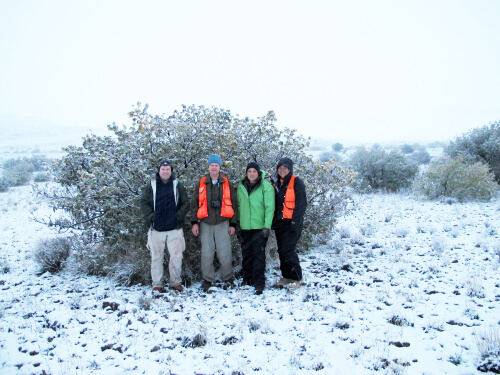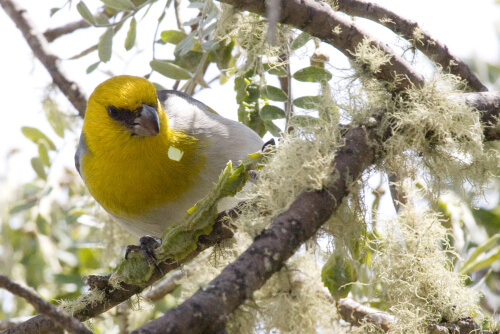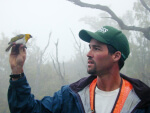White-out on the White Mountain: Restoring Forests on Mauna Kea
Hawai'i's not all white sands and beaches. This snow-covered truck awaited our freezing field crew on Mauna Kea. Photo by Robert Stephens
By Robert Stephens, Project Coordinator, Mauna Kea Forest Restoration Project
January 28, 2014, 7 a.m., Hilo, Hawai'i: As the field crew of the Mauna Kea Forest Restoration Project (MKFRP) drove up the rough dirt roads in the Mauna Kea Forest Reserve and parked on Skyline Road—10,300 feet high on the flanks of the dormant volcano—the conditions were dry. But the building clouds had an imposing darkness. The weather reminded Cheyanne Rapoza, Field Crew Leader, of a snowstorm that delayed the annual Palila surveys in 2011.
The goal for the six field staff that day was to split into two groups of three, with each group surveying two of the four final vegetation plots selected from a sample of 60. These surveys would assess current forest conditions and help serve as a baseline for habitat recovery for the Palila—last of the 16 “finch-billed” honeycreepers that used to occur in the main Hawaiian Islands.

Field staff in a snow storm on Mauna Kea, 2011. Left to right: Chris Farmer, ABC; Paul Banko-USGS; Cheyanne Rapoza-MKFRP; and Ku'ulei Vickery-MKFRP. Photo by Robert Stephens
Unfortunately, Cheyanne's intuition was correct. At the first survey plot, a light but cold rain began to fall. What started out as just wet and cold hands (especially if you were holding the metal clipboard!) progressed to a numbness that crept toward their body cores over the three hours spent working in the constant rain fall. By the time Cheyenne's crew was halfway finished surveying their second plot, they had decided to take refuge from the cold, wet conditions.
Snow in Hawai'i?
Thirty minutes into the arduous 1.5 hour slog back uphill to the truck, the rain turned to a heavy snowfall, coming down sideways due to the gusty winds on the mountain. Nearly two inches of snow had accumulated on the truck by the time the shivering surveyors reached it. The crew cranked the heater to high as they descended from snowy Mauna Kea back to sea level and a warm 70 degrees F in Hilo. Along the way they picked up the other crew, who had completed their two transects and were also soaked and ready to retreat from the weather.
Think about it … snow in Hawai'i?! This event reminds us how special Mauna Kea is. Mauna Kea means the “white mountain” in Hawaiian because of its snow-covered peaks. It's quite different from how many people envision Hawai'i. It is extremely rough and rugged, with temperatures regularly falling below freezing. It is one of the most sacred sites of Native Hawaiians, one of the best sites in the world for astronomical observations—and, of course, home to the Palila.

The Palila is a Hawaiian honeycreeper that is specially adapted to feed on the seeds of māmane trees, which grow on the high-altitude slopes of Mauna Kea. Photo by Robby Kohley
Paving the way for Palila recovery
This project is working to restore high-elevation dry forest for the Palila, a Hawaiian honeycreeper listed as endangered in 1973. This Critically Endangered bird now occurs only on the southwestern slope of Mauna Kea, which is less than five percent of its historical distribution on Hawai'i Island.
Palila are dependent upon māmane trees, a legume (pea family), that provides these birds with about 90 percent of their diet in the form of seeds that are toxic to most other animals, yellow flowers, young leaves, and moth larvae found in the seed pods.
Bye-bye black sheep
In 2013, the Hawai'i Division of Forestry and Wildlife (DOFAW) began an eradication program to remove all hybrid-mouflon sheep from critical habitat designated for the Palila. Non-native ungulates like these have destroyed much of the forest over the past 200 years, and what remains is highly degraded due to continuing browse damage, drought, invasive plants, and fire.
Over 3,000 sheep were removed from Palila Critical Habitat in 2013. Natural regeneration of māmane seedlings should increase habitat for the bird as sheep continue to be removed from Mauna Kea.

A view of the slopes of Mauna Kea from the air, showing habitat degradation caused by the grazing of introduced non-native sheep. Photo by Robert Stephens
Signs of success
Project staff are already observing habitat recovery at the 1,400-acre Ka'ohe Restoration Site, which was fenced in 2006 and has been sheep-free since then. Māmane saplings are over seven times more abundant at this site than on the other side of the fence, where sheep are still present.
American Bird Conservancy is a strong supporter of the work DOFAW and MKFRP are doing to restore forest on Mauna Kea and ensure the long-term viability of the Palila. To learn more about Palila ecology, threats and management, visit restoremaunakea.org.
 Robert Stephens currently serves at the Coordinator for the Mauna Kea Forest Restoration Project and started working with Palila on Hawai'i Island in 2005. Previously, he worked for the Idaho Department of Fish and Game and the Wyoming Game and Fish Department. He received a B.S. degree in Wildlife Biology from Colorado State University and a M.S. degree in Zoology and Physiology from the University of Wyoming.
Robert Stephens currently serves at the Coordinator for the Mauna Kea Forest Restoration Project and started working with Palila on Hawai'i Island in 2005. Previously, he worked for the Idaho Department of Fish and Game and the Wyoming Game and Fish Department. He received a B.S. degree in Wildlife Biology from Colorado State University and a M.S. degree in Zoology and Physiology from the University of Wyoming.


















































